Speech Data Exploration
Contents
Speech Data Exploration¶
import pandas as pd
import seaborn as sns
from matplotlib import pyplot as plt
Initial exploration of the dataset¶
Here we can get a first idea of what the dataset looks like and what values are represented. As can be seen the dataset consists of 354 speeches each being accompanied by the following columns:
ID
Speaker
Party
Location
Date
Name of the speech
Speech
There are no NULL values in our dataset.
The .sample() function gives a peak into the values of our dataset.
df = pd.read_csv('Code/speech_metadata.csv')
df.info()
df.describe()
<class 'pandas.core.frame.DataFrame'>
RangeIndex: 354 entries, 0 to 353
Data columns (total 7 columns):
# Column Non-Null Count Dtype
--- ------ -------------- -----
0 id 354 non-null object
1 speaker 354 non-null object
2 party 354 non-null object
3 location 354 non-null object
4 date 354 non-null object
5 name speech 354 non-null object
6 speech 354 non-null object
dtypes: object(7)
memory usage: 19.5+ KB
| id | speaker | party | location | date | name speech | speech | |
|---|---|---|---|---|---|---|---|
| count | 354 | 354 | 354 | 354 | 354 | 354 | 354 |
| unique | 354 | 54 | 5 | 62 | 347 | 341 | 354 |
| top | Conservative_0 | Paddy Ashdown | Labour | London | 1998 | Leader's speech, Brighton 1971 | Thank you very much for that warm welcome. You... |
| freq | 1 | 45 | 123 | 58 | 3 | 2 | 1 |
df.sample(5)
| id | speaker | party | location | date | name speech | speech | |
|---|---|---|---|---|---|---|---|
| 178 | Labour_178 | Tony Blair | Labour | Blackpool | 01/10/1996 | Leader's speech, Blackpool 1996 | Diana, friends, colleagues, this year we meet ... |
| 13 | Conservative_13 | David Cameron | Conservative | Birmingham | 01/10/2014 | Leader's speech, Birmingham 2014 | I am so proud to stand here today as Prime Min... |
| 304 | Conservative_312 | Stanley Baldwin | Conservative | Blackpool | 07/10/1932 | Leader's speech, Blackpool 1932 | Mr. Baldwin thanked Blackpool for the great we... |
| 37 | Conservative_37 | David Cameron | Conservative | Shipley | 28/05/2010 | "Transforming the British economy: Coalition s... | This is my first major speech as Prime Ministe... |
| 132 | Labour_132 | Tony Blair | Labour | Bournemouth | 28/09/1999 | Leader's speech, Bournemouth 1999 | Today at the frontier of the new Millennium I ... |
Some exploratory queries & visualizations¶
Speech counts¶
Below we see some visualizations related to the amount of speeches in the dataset.
We can see from the first horizontal barplot that the Labour party and Conservative party have the most speeches in the dataset (around 120 each), followed by the Liberal Democrats and the Liberal party with around 65 and 45 speeches respectively. The SPD-Liberal Alliance has only a few speeches in the dataset.
NOTE: The Liberal party merged with the SPD-Liberal Alliance to form the Liberal Democrats in 1988.
The second horizontal barplot looks at the 10 speakers that gave the most amount of speeches.
Most of the speakers that have over 20 speeches appeared after 1988, which brings us to the final lineplot.
In the final lineplot we can see that most speeches appeared around the 90s up until the 2010s with a high peak around the 1995-2000 period.
#count speeches per party
df.value_counts(['party']).sort_values(ascending=True).plot(kind='barh');
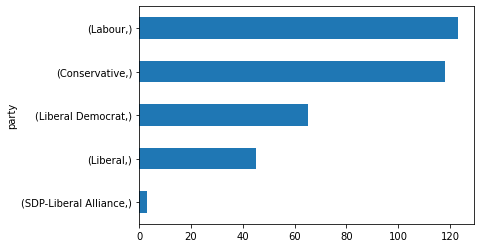
#count speeches per speaker
df.value_counts(['speaker'])[:10].sort_values(ascending=True).plot(kind='barh');
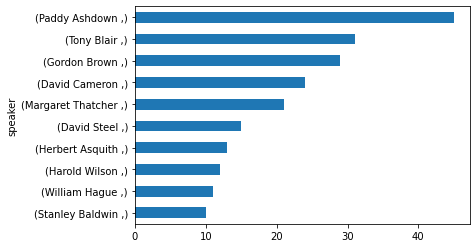
#speeches per year
years = []
for date in df['date']:
years.append(date[-4:])
df['year'] = years
df['year'].astype('int')
df['year'].value_counts().sort_index(ascending=True).plot.line();
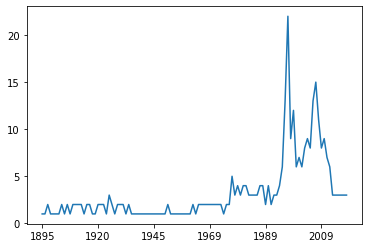
Location¶
This visualization looks at the cities which have been visited the by the parties.
A significant number of speeches for both the Labour and the Conservative party have been given in Blackpool.
This could be explained by the Winter Gardens which used to routinely host these political conferences.
Additionally, seaside towns like Brighton, Bournemouth and Blackpool, have been the hosts of UK-wide political conferences partly because of the cheap accomodation outside the holiday season.
More recently however, these events have been moved to more major cities which have purpose-built conference centres.
Therefore we can see that more major cities like London and Birmingham also have a fair share of speeches attributed to them.
Another interesting observation is that Birmingham has no Labour speeches whereas the Birmingham council has a majority of Labour councillers.
#location speeches per party
parties = df['party'].unique()
party_location_dic = {}
for party in parties:
partyloc = df.loc[df['party'] == party]
partyloc = partyloc['location'].value_counts()[:10]
party_location_dic[party] = dict(partyloc)
dft = pd.DataFrame([(i,j,party_location_dic[i][j])\
for i in party_location_dic.keys()\
for j in party_location_dic[i].keys()], columns=["party", "city", "times visited"])
fig = plt.figure(figsize=(10,15))
ax = sns.barplot(x="times visited", y="city", hue="party" ,data=dft)
plt.legend(loc='lower right')
plt.show()
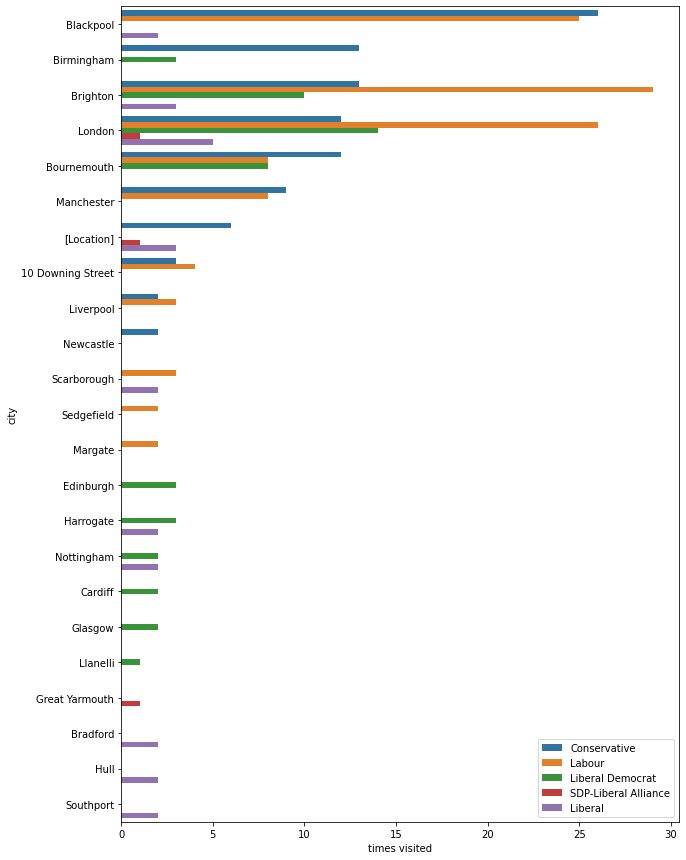
Sentence length¶
The visualizations below will give an overview of the length of the speeches per party.
Firstly we can observe the mean of the length of every speech per party.
Interestingly, the Labour and Conservative party have a similar average speech length.
Additionally, the SPD-Liberal Alliance seems to have a relatively short speech length, however, this could be explained by the low number of speeches in the dataset.
The Liberal party has the highest average speech length with Liberal Democrats having, comparatively speaking, a short average speech length.
Secondly, the lineplot visualizes the fluctuation of average speech length over the years.
We can see some dips and peaks in the lineplot which is indicative of some of the outliers in the dataset.
It is fair to say that most speeches range from around 15000 words to around 35000 words, which can be observed more clearly in the final part of this exploratory analysis.
#average length of speech per party
df['speech'] = df['speech'].fillna('').astype('string')
df['length_in_words'] = df['speech'].apply(len)
df.groupby('party').mean('length_in_words')
| length_in_words | |
|---|---|
| party | |
| Conservative | 26133.000000 |
| Labour | 26521.162602 |
| Liberal | 30570.622222 |
| Liberal Democrat | 21201.492308 |
| SDP-Liberal Alliance | 14022.000000 |
#average speech length per year
df.groupby('year').mean('length_in_words').astype('int').plot.line();
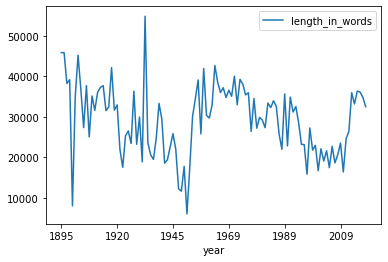
Boxplot with the length of speeches per party¶
In this boxplot we can see the differences between the length distribution per party.
At first glance, we can see from this boxplot that the greatest distinction is between Liberals and the other two parties.
The Conservative party’s ‘shortest’ speech has around 50 words and the ‘longest’ speech has around 47000 words.
The majority of the speeches from the Conservative party have between 20000 (Q1) and 35000 words (Q3).The Labour party’s ‘shortest’ speech has around 2000 words, whereas the ‘longest’ speech has over 51000 words.
The majority of the speeches from the Labour party have between 15000 (Q1) and 35000 words (Q3).The Liberal party’s ‘shortest’ speech has around 8000 words, whereas the ‘longest’ speech has around 55000 words.
NOTE: Important to note here is that these speeches are outliers in the Liberal speeches.
The majority of the speeches from the Liberals have between 25000 (Q1) and 35000 words (Q3).
df_three = df.loc[(df['party'] == 'Conservative') | (df['party']=='Labour') | (df['party']=='Liberal')]
sns.boxplot(x='party',y='length_in_words',data=df_three);

print('Conservatives')
print(df_three.loc[df_three['party'] == 'Conservative'].describe())
print('Labour')
print(df_three.loc[df_three['party'] == 'Labour'].describe())
print('Liberal')
print(df_three.loc[df_three['party'] == 'Liberal'].describe())
Conservatives
length_in_words
count 118.000000
mean 26133.000000
std 10955.536236
min 56.000000
25% 20025.250000
50% 27488.000000
75% 34431.750000
max 47490.000000
Labour
length_in_words
count 123.000000
mean 26521.162602
std 12770.481760
min 2471.000000
25% 15515.000000
50% 29320.000000
75% 35934.000000
max 51549.000000
Liberal
length_in_words
count 45.000000
mean 30570.622222
std 9148.845377
min 8051.000000
25% 25877.000000
50% 30924.000000
75% 35141.000000
max 54887.000000
